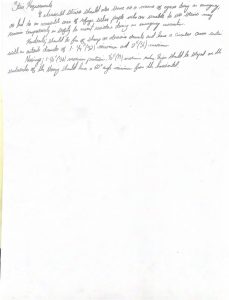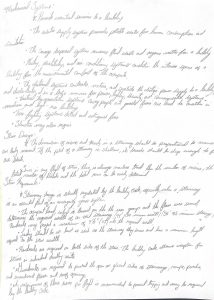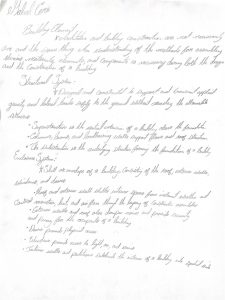Sketching sections of the the federal hall building helped me to understand the relationship between all cutting walls and grounds. I was able to show not only the cut lines through the center on the building but the materials that were being used to style of support the structure. It is important to include accurate proportion through out your drawing because if you don’t, drawings will look distorted. A way to do this can by counting the tile on ground or brick on the walls to find heights and widths. To show scale in sketch drawing, the use of people at realistic heights can show the correlation of the person to the space.
Category: Uncategorized (Page 2 of 5)
On Friday October 18th we have visited the highline which in my opinion is a great place to study about structural elements of buildings because of the new construction that takes place there. There are many buildings under construction that does not have yet completed the envelope, so the structural elements such as columns and beams are still exposed and it was easier for us to understand the structural grid system of these buildings. In addition to the buildings under construction we also looked at the existing buildings. Looking at some of the older existing building we were able to see how did the the building technology moved forward, as these older buildings were not properly protected against weather, moisture and temperature as the current standards require. The thing that struck me the most was the beginning of highline as I did not know that the part of highline was literally cut out. This was actually helpful for our trip as we were able to see the beams that support highline in section.
Last week we started to do our first drawing for the layout of Town hall. This is my first draft drawing since transferring into this new major. I found it a little difficult at first because i didn’t understand the angles, degrees, and the relationship the site has in terms of the construction of the building. From doing my study drawings and going around with my class analyzing and studying the relationship that each part of Town Hall has and drawing a mini scale of our site, i got a better understanding of the relationship and how they interact in a very particular way. For instance the columns in the back of our site vs. the windows diagonal the columns, they are at the same position on a specific angle. Last week while doing the drawings i got a better understanding on not only how to draw a floor plan, but also how angles, degrees, and placements also an important key.
The Drawings we did are only a rough draft on what it would look like if we were architects and knew how to design the plan. This is only the first piece of our site drawing. In the next class we will get right to the cut and understand a better relationship with the door plan and use our senses to see and understand and make a replica of the floor plan for Town Hall.
The drawing assignment for the Federal Hall Building was very interesting. I learned how to distinguish different line types used in a plan, how to make my drawings more efficient, and that it is best to start from the biggest part of the drawing to the smallest detail. The three different line types that I learned about were solid lines (which are the actual lines with no breaks), center lines ( consists of lines and dots in between ), and grid lines ( lines and dashes). Implementing these line types will help to make my work clearer and easier to read. When it comes to the order of what to draw first its best to start with the biggest parts to the smallest details, completing the biggest tasks first helps to keep your work organized and even. To be sure that my work is neat, I learned that I can create a bounding box around the original drawing and extend the lines so that each line meets at the same points.
On Friday we started the first of many drawings,of the federal hall plans. Using different line types we essentially divided the main rectangular form into subsections that will form the different rooms and areas of the building. Using center-lines (line and dot) we divided the rectangle in half horizontally and also drew a center-line down vertically for the circle. Using grid lines(line and dash) we marked the center of the peers, surrounding the outside wall. Lastly we learned how to use an adjustable triangle. After doing some quick math, we used the triangle to give us 15 degree angles around the circle. I’ve always known how to draw. But there is a level of precision, detail, and most of all structure that differentiates artists from architects. Line weight and thickness matters. Therefore it pencil should always be sharp. The consistency of my grid and center-line makes a difference. Obviously the precision of my scales measurements and how to properly layout the measurements so that it does not interfere with my model or drawing. All these little details will definitely make the difference between B level work and A level work.
The Federal Hall drawing assignment was a nice first project. In Arch 1101 I did some precision drawings of few structures but the Federal Hall is on a whole different scale and popularity than previous drawings. I learned many things from this assignment such as drawing the big pieces of a building first really should be the first steps to any drawing. Drawing the smaller parts of a building is better to do last because working with the bigger parts would really put the hard work away first and let you focus on the little details. I enjoy this assignment because drawing precise is basically the reason i chose this program and its great to use software to design but the foundations of architecture started off with drawings and would always be the majority of the basics. I am looking forward to finishing this assignment in the coming weeks.
This reading gave foundations of architecture such as the principles, phases and resources we think about when we plan designs. These two chapters were very detailed but had main points that stood out such as sections 1.08-1.15 give some incite on weather conditions to consider but point out soils, trees, sun light, rain and just the basic components that destroy or hurt a building. Next parts of the chapters discuss the type of structural systems, like steel lateral rigid frames , braced frames etc. This chapter is great because it would always be a reference point when designing for the real world. Ching goes on to give the basic measurements of the most common infastructures like sidewalks and bike lanes. Overall these two chapters are foundations of architecture and a place to always come back to if ever needed clarity.
Reading one has allowed me to understand that the design of a building consists of several elements and systems before it is constructed. Bricks, wood, steel, concrete, and cmu are a variety of materials that can be used in the construction of a building. The materials in conjunction with some form of adhesive can help prevent deterioration of a structure and combat various weather conditions. Each material has it’s own strength and are therefore stronger when combined. Architecture have several branches many of which are dependent on each other and build on each other. What i found the most interesting from the reading was how intricate architecture is, from the breakdown of the different types of the materials to the relationship between a building element and its properties. I never thought that I would have a favorite materials but the diversity and the multi-usage of bricks have peaked my interest; from how they are made to how they can be use and the many ways it can be laid to create different patterns.






